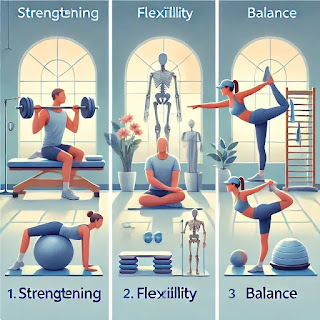 |
Therapeutic Exercises: Strengthening, Flexibility, and Balance Exercises
Therapeutic exercises are structured, purposeful physical activities designed to restore, maintain, or improve strength, flexibility, and balance in individuals recovering from injuries, surgeries, or chronic conditions. These exercises are tailored to a patient’s specific needs and play a crucial role in rehabilitation, pain relief, and overall physical well-being.
1. Strengthening Exercises
Purpose:
- Improve muscle strength and endurance
- Enhance joint stability
- Prevent muscle atrophy (weakening)
- Support recovery from injuries or surgeries
Types of Strengthening Exercises:
A. Isometric Exercises (Static Strengthening)
- Involves muscle contraction without movement
- Beneficial for early-stage rehabilitation and joint stability
- Example: Plank hold, wall sit, and quadriceps setting (tightening thigh muscles while keeping the knee straight)
B. Isotonic Exercises (Dynamic Strengthening)
- Involves muscle contraction with movement
- Helps in building strength and endurance
- Example: Squats, lunges, bicep curls, and resistance band exercises
C. Progressive Resistance Exercises (PREs)
- Uses increasing resistance (weights, resistance bands)
- Helps in gradual muscle strengthening
- Example: Dumbbell lifting, leg press, and resistance band pulls
D. Functional Strength Training
- Mimics daily activities to restore strength in practical movements
- Example: Sit-to-stand exercises, stair climbing, lifting objects safely
2. Flexibility Exercises
Purpose:
- Improve joint range of motion (ROM)
- Reduce muscle stiffness and pain
- Prevent injuries
- Aid in post-exercise recovery
Types of Flexibility Exercises:
A. Static Stretching
- Holding a stretch position for 15-30 seconds without movement
- Helps improve muscle length and joint flexibility
- Example: Hamstring stretch, quadriceps stretch, calf stretch
B. Dynamic Stretching
- Involves controlled movements that stretch muscles
- Helps in warming up before activities
- Example: Leg swings, arm circles, walking lunges
C. Proprioceptive Neuromuscular Facilitation (PNF) Stretching
- Involves a combination of muscle contraction and relaxation
- Improves flexibility faster than static stretching
- Example: Assisted hamstring stretch with resistance
D. Yoga and Pilates
- Improve flexibility, posture, and muscle control
- Helps in reducing stress and muscle tightness
3. Balance Exercises
Purpose:
- Improve postural stability and coordination
- Reduce the risk of falls (especially in elderly individuals)
- Enhance neuromuscular control for injury prevention
Types of Balance Exercises:
A. Static Balance Training
- Maintaining balance while standing still
- Example: Standing on one leg, heel-to-toe stance
B. Dynamic Balance Training
- Involves moving while maintaining balance
- Example: Walking heel-to-toe, balance beam walking
C. Proprioceptive Training
- Enhances the body's ability to sense its position in space
- Helps in recovering from ankle/knee injuries
- Example: Standing on a balance board, wobble cushion exercises
D. Core Stability Training
- Strengthens the core muscles (abs, lower back) for better posture and balance
- Example: Plank variations, stability ball exercises
Conclusion
Therapeutic exercises, including strengthening, flexibility, and balance training, are essential for rehabilitation, injury prevention, and overall well-being. These exercises must be performed under proper guidance to ensure safety and effectiveness. A personalized exercise program can significantly enhance a patient's mobility, strength, and quality of life over time.







0 comments:
Post a Comment